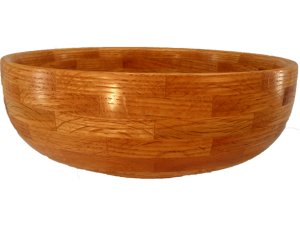Segmented Utility Bowl Using Low Tech Design Approach
Also may be viewed on YouTube.
Recently a viewer asked for the segment sizes for a lidded bowl. Normally, I’m willing to share details except that from the tone of the email, I thought that he wanted to make the project without any understanding of how to figure out segment sizes.
I believe that anyone doing segmented work needs a basic understanding of how to design and calculate segment and ring sizes.
Since not everyone is as comfortable with a computer as I am, I decided to take a low tech approach to designing this lidded bowl. Then anyone with or without a computer can easily figure out segment sizes to any segmented project they want.
This bowl is oak, almost 10 inches in diameter and 3.5 inches tall, finished with walnut oil, and buffed.
The bowl has seven segment rings of twelve segments each for 84 segments plus a piece of home made oak plywood. The plywood prevents segments from splitting when closely spaced in the bottom.
Good turning.

Hi Alan, been out of touch for a while – but have been watching your videos.
Interesting presentation of non-CG designing, but perhaps yet a bit overly numeric. A bit over a year ago, when fussing with some “crazy rollers” (is that what you called them) and other streptohedrons I went Greek. 3.1317xxxx (to infinity) isn’t Pi, it approaches Pi. Pi is 11/7, a ratio of whole numbers – come to think of it so is the Golden Ratio.
I bought a good compass, I didn’t need a new straight edge, and some Staples poster paper (just stiff enough). I did a bit of review of plane geometry, and a bit beyond the HS level, and found that one can make patterns with a compass and a straight edge that are more accurate than anything one can do with a protractor and math. Even better than with a square to make a square, the square will slip, the compass won’t.
Just having fun, I was well impressed by them darned old Greeks and the compass and straight edge. We can carry on to the forms and shapes without using numbers, just the ratios made by the repeated divisions of the patterns with the compass. Fibonnacci and golden ratio and the common square and circle.
Best, Jon
Jon, sounds interesting but potentially more intimidating than my low tech approach.
Amazing what they did without a calculator.
Alan